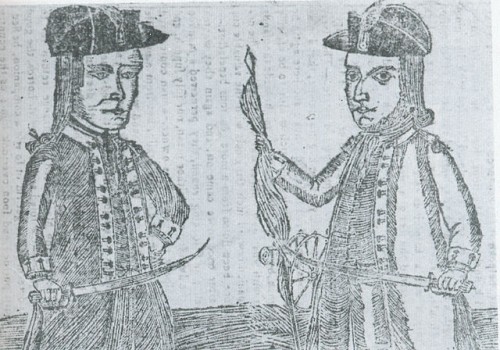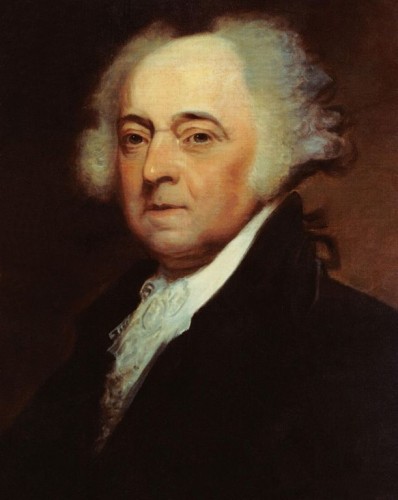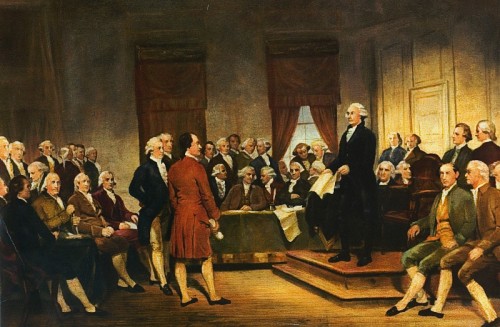Our Kingsley Ancestors and Shays’s Rebellion

McMurray Family (Click for Family Tree)
If you are a McMurray, Payne, or Burnell descendant, you might be interested to know that today, 29 August, is the anniversary of the beginning of Shays’s [sic] Rebellion.
Dr. Edward A. McMurray, Dr. Herbert C. McMurray, and Maude Lynette “Midge” McMurray Cook were the third-great grandchildren of Ebenezer Kingsley (1769-1855), and fourth-great grandchildren of Ebenezer’s father, Deacon Moses Kingsley (1744-1829), so you can figure your relationship from them.
Ebenezer Kingsley and his father (and family) were living in Northampton, Hampshire County, Massachusetts, in 1786, the epicenter of Shays’s Rebellion. Northampton is in the western part of the state, which was very rural, with subsistence farming its primary economic base in the rolling hills of the valley. About 85% of the population was living on small farms in the backcountry in 1786, trying to eke out a spare living for their family.

So what was Shays’s Rebellion about, if you have forgotten high school history?
First, a bit of background on the times:
The Revolutionary War was over and the Articles of Confederation were the weak glue holding the thirteen ex-colonies together. The fledgling government did not have enough money to pay soldiers for their service or the promised bounties, so many returned home penniless, and in debt for their farms or businesses, whether it be a mortgage, supplies and livestock bought on credit, or taxes while they were off fighting for our freedom. Businesses were in great distress because of the disruption of commerce due to the war, plus they could not pay their bills since their customers could not make good on what they owed. There was no demand for labor since there was no money to pay workers, and the towns, states, and country were all in debt due to the war. The lost income to individuals, businesses, and thus tax revenues due to the war, overall must have been staggering, and triggered the first post-war depression of the new United States of America’s economy.
The states and the federal government, of course, levied taxes to pay their debts, but the citizens did not have the money to pay. Some estimated that the state of Massachusetts had debt equal to almost $200 for every family in the state; they levied an additional property tax to pay this debt. Prior to the war, the barter system had been used as hard money was scarce, but the government would not take livestock or crops- if a farmer even had some to spare- in lieu of cash to pay taxes. The laws of the time required property to be seized from debtors, and unjustly allowed the first of the creditors to take all the property, not giving proportionate amounts to other creditors, who then would not be able to pay their own loans. Debtors were thrown into prison with felons, and “families left to want and poverty.”
“Heavier than the people can bear” was the comment made by John Adams when describing the economic situation and tax burden of the people, even though he was normally a conservative.

Law-abiding citizens wrote petition after petition for relief to the state government in Boston, with no reply and no decrease in taxes.
Our Kingsley ancestors would have felt this burden keenly, as it appears that they were not very well-to-do. The 1820 US Federal Census indicates that Moses Kingsley was still working in agriculture at age 76, and at least two of his sons, Ebenezer and Asahel, were also farmers.
Describing Shay’s rebellion, the Gazetteer of Hampshire County, Mass., 1654-1887, states:
“This uprising in Western Massachusetts against the authorities of the state, in 1786, was not, however, strickly [sic] speaking, a rebellion; that is, it was not prompted by any spirit of disloyalty, nor was it designed or plotted with the wish to overturn the government. It was the wild and lawless expression of discontent with harsh circumstances; the natural outbreak of those who were suffering and oppressed.
… As the courts and lawyers were instrumental in the foreclosure of mortgages, the distraining [seizure to pay off debt] of personal property and the imprisonment of debtors, the popular outcry and rage was largely directed against the officials of law and justice.”
An earlier mob outbreak had disturbed the court session in Northampton in April of 1782, when Ebenezer was just 13, and his father, Moses Kingsley, 38 years old and a pillar of his community. The mob leader was arrested, then broken out of jail in another city by his comrades, who were then arrested in Northampton. A mob came to Northampton demanding their release, which did occur. This must have been a scary time for the local population, though likely exciting to a 13 year old boy like Ebenezer Kingsley!
Four years later, conventions were convened in the state to rectify these same problems in August of 1786. It was, however, too late: 1500 people mobbed the Northampton Courthouse and grounds on August 29th to prevent any cases against debtors proceeding. Daniel Shays and Luke Day, both who served admirably in the Revolutionary War, became the leaders of the rebellion. (Many other rebels had served honorably in the Revolutionary War as well.) When peaceful means did not work, they issued a call to arms and violent protest by the citizenry, which did happen that fall in other towns. The rebels were able to stop courts before they could convict debtors, and moved from town to town, inciting revolt. They saw themselves as “Regulators,” trying to make taxation fair and reducing official corruption, not rebels.
Fearful of the economic and possible political effects of this revolt, a private militia was raised by wealthy merchants and land owners, since the state of Massachusetts did not have the funds to pay a militia to put down the rebellion. Forty-five hundred men were enlisted, 1200 to be raised from Western Massachusetts in December.
Ebenezer Kingsley was 18, his brother Asahel Kingsley (1771-1864) was 16, and brother Moses Kingsley (1772-1828) was 15 at this time- perhaps they participated in the militia, or possibly even in the rebellion? What if one felt the rebellion necessary, and another felt it important to put it down? Young men of that age are often eager to test their mettle in battle, and they had been just children during the Revolution so could not serve then. Their father Moses Kingsley was 44 and had become the 21st Deacon of First Church in Northampton. It must have been a difficult time for him- as a Deacon and a farmer himself, he likely would understand the pain of the people concerning their inability to pay their debts in such challenging economic times, yet as a man of the church he would want the law to be obeyed.
As Shays’ men needed arms, they decided to attack the US Arsenal in Springfield, MA. They were stopped by the militia, and the “Shaysites” as they were called, retreated after 3 were killed and one severely wounded. The militia pursued the rebels up the hills in the snow and cold winds of a Massachusetts January, and rebels deserted the cause in droves; the rebellion was essentially over. Over four thousand men signed confessions of wrong-doing, and were required to swear an oath of allegiance to the state and those who governed.
Elections brought a new, more responsive group into power and they placed a moratorium on debts collected by the state, plus cut taxes.
Some have called Shays’s Rebellion the last battle of the Revolutionary War, as the citizens were rebelling against an elite group in far away (Boston) levying taxes that were much too high for the average person to pay. George Washington came out of retirement to help the government determine what to do about the rebels, and he went on to become President in 1789. The Rebellion revealed the inadequacy of the Articles of Confederation, thus a Constitutional Convention was convened, resulting in the Constitution we still use today.

Thomas Jefferson, French Ambassador at the time, was not concerned that Shays’s Rebellion would destroy the new country he had worked so hard to build. One of his most famous quotes comes from a letter he wrote about Shays’s Rebellion: “The tree of liberty must be refreshed from time to time with the blood of patriots and tyrants. It is its natural manure.” [fertilizer]
Hopefully, the positive political aftermath of Shays’s Rebellion helped our Kingsley ancestors in their pursuit of liberty, success, and happiness.
Notes, Sources, and References:
- Gazetteer of Hampshire County, Mass., 1654-1887, page 100, via Archive.org. https://archive.org/stream/gazetteerofhamps00ingayw#page/n113/mode/2up
- Shays’s Rebellion: The American Revolution’s Final Battle, by Leonard L. Richards, University of Pennsylvania Press, 2002.
- 1820 US Federal Census for Moses Kingsley in Hampshire, Massachusetts: Detail: Year: 1820; Census Place: Hampshire, Massachusetts; Roll: M33_50, via Ancestry.com.
- Further research into the newspapers of the time in Northampton, researching court documents that might include a confessions, diaries, militia lists, etc., might give us more insight into exactly how the Kingsley family fit into Northampton in 1786, and how they were affected by Shays’s Rebellion.
Please contact us if you would like higher resolution images. Click to enlarge images.
We would love to read your thoughts and comments about this post (see form below), and thank you for your time! All comments are moderated, however, due to the high intelligence and persistence of spammers/hackers who really should be putting their smarts to use for the public good instead of spamming our little blog.